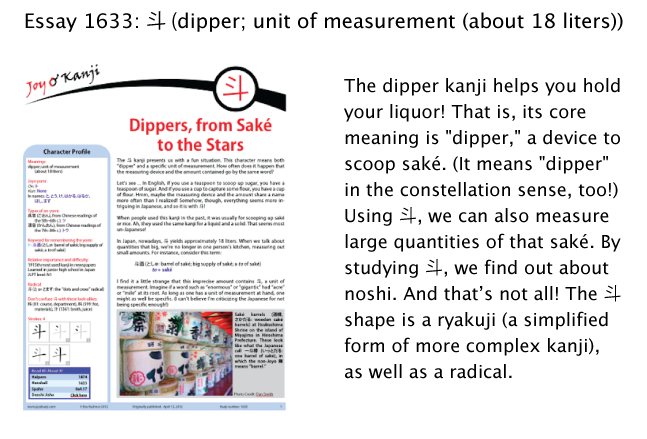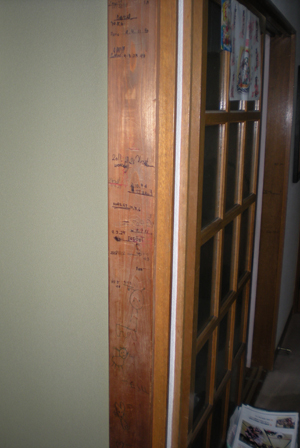The Scratch Marks of Your Life
In the past, when Japanese men proposed marriage, they used an abalone as a betrothal gift! How would you like to receive such a fishy offering?! Here's the word for that present:
長熨斗 (ながのし: dried abalone stretched long and thin (used as a betrothal gift))
long + flatiron, to smooth out + dipper
The newly published essay 1633 on 斗 (dipper) shows how this gift has left a legacy in the form of のし (written in kanji as 熨斗). A のし is now a long strip of paper that the Japanese attach either to a gift or to an envelope containing money. As the essay notes, "Few Japanese people mentally connect this のし with either the kanji rendering 熨斗 or the abalone meaning."
Here's a preview of essay 1633:

Fortunately, dried abalone didn't enter into the picture when my husband and I decided to marry. Our wedding took place 20 years ago today! It has felt so easy to be together that I can't quite grasp where the decades have gone.
In fact, I could say the same thing about my life in general, and I know I'm far from alone in that. Happy or not, most of us feel amazed and awed by the way the planet keeps on whipping around the sun. One birthday follows on the heels of another with almost no time to rest in between! And if our adult lives seem to be speeding by, that's nothing compared with the effect of time on a child's life. It feels as if my friends just started having babies recently, but this year a whole crop of them turn 10. Next thing you know, they'll be at their own weddings!
In many respects, I keep track of the years obsessively, just because I do everything obsessively! It turns out that the Japanese do the same thing, only they have a well-defined system for measuring the passage of time. It has to do with this object:
柱 (はしら: post; pillar)
In Japanese-style houses, people mark children's heights once or twice a year on one of the many 柱. They typically scratch lines into the wood (and cats like to follow suit by adding scratches of their own!). My proofreader says he instead uses a magic marker to record the way his grandson and granddaughter have grown. Shoji-san comments, "For grandparents, it’s a great pleasure to record the heights of their grandchildren whenever the kids visit."

Photo Credit: Shoji Matsumoto
The scratch marks on the 柱 in Shoji-san's house
When my sister and I were young, my mother used a pencil in a doorway to mark our heights, not that we ever grew much. But then the marks disappeared with a kitchen remodel. They would certainly have vanished with a house sale.
This probably wouldn't happen in Japan, particularly now that the Japanese can buy a portable 柱. With this item, people needn't damage the pillars of their houses and can take their personal histories along when they move. Great idea! And look how cleverly the advertisers played with the shape of the 柱 kanji in the beginning of the ad!
As Shoji-san explains, though, Japanese families tend to hold onto houses, passing them down through the generations and keeping the marks on 柱 intact. (He notes that if people do want to erase this history, they can easily plane off the surface of the wood with a かんな, written in kanji with the non-Joyo 鉋.)
Of course, these marks have a history far older than any particular family's 柱 would indicate. Shoji-san says that this custom of comparing children's heights goes way back in Japanese culture and even serves as the title of the 1895 novel たけくらべ by Ichiyo Higuchi. (Check out Higuchi's impressive biography on Wikipedia. She left a mark on Japanese literature even though she died at just 24! She never had a chance to ask in wonderment, "Where have all the years gone?")
That novel title, たけくらべ (for which the kanji would be 丈比べ: height + comparing), is a term for comparing statures, though Shoji-san says that the book uses this word only figuratively in depicting the changing lives and struggles of several children. People also call this custom 背比べ (せいくらべ: height + comparing).
Oh my goodness! I just remembered that I wrote extensively about 背比べ in my old blog, Kanji Curiosity. There I became giddy with the realization that the top of 背 represents a back-to-back comparison of people's heights and that 比 shows two figures seated side by side, which leads to the idea of comparison. In 背比べ, then, we find four people!
I wrote that blog entry three years ago (if you happen to be keeping a mental 柱 of my personal history!) because I had seen a sign in New Zealand about comparing one's height to that of a penguin. That's not how the Japanese normally use this word!
Instead, 柱 is more likely to pop up in children’s songs, including one from 1966 called たけくらべ. The song is actually about a film version of the famous novel! Here's the first verse, in which たけくらべ appears as the last word:
ききょうの匂い 抱きしめて
遠く離れる 君想う
格子の間より みかけた姿
幼き夢の たけくらべ
〜Lyrics by 大矢弘子 (おおや ひろこ)
ききょう (bellflower); 匂い (におい: fragrance); 抱きしめる (だきしめる: to hold closely); 遠く離れる (とおくはなれて: at a long distance); 君 (きみ: you); 想う (おもう: to think); 格子 (こうし: lattice); 間 (あいだ: between); みかける (見かける: to catch sight of); 姿 (すがた: figure; form; shape); 幼き (おさなき: very young); 夢 (ゆめ: dream)
Shoji-san has thoughtfully provided not only the lyrics but also this translation: "With fragrant bellflowers in my arms, I think of you, who live far from me. A glance at you through the lattice window of one of the licensed pleasure quarters reminds me dearly of the たけくらべ we enjoyed in our tender years."
As he explained to me, 格子 (lattice) turns into "licensed pleasure quarters" in the translation because each structure in those quarters had a latticed front entrance, enabling passers-by to peep in and see the women working there. Meanwhile, 夢 (dream) in the lyrics represents something that reminds someone of enjoyable past days.
A song from 1925 called 背くらべ also refers to the custom of comparing children's heights. Here's the first verse:
柱のきずは おととしの
五月五日の 背くらべ
粽たべたべ 兄さんが
計ってくれた 背のたけ
きのうくらべりゃ何のこと
やっと羽織の 紐のたけ
〜Lyrics by 海野厚 (うんの あつし)
きず(傷: scratch); おととし (一昨年 : year before last); 五月五日 (ごがついつか: May 5, which is Children's Day); 粽 (non-Joyo kanji read as ちまき: rice dumpling steamed in bamboo leaves; Children’s Day special); たべる (食べる: to eat); 兄さん (あにさん: elder brother); 計る (はかる: to measure); 背 (せ: height); たけ* (丈: height); きのう (昨日: yesterday); くらべる (比べる: to compare); 何のこと (なんのこと: what a surprise); やっと (barely, narrowly); 羽織 (はおり: haori, a Japanese formal coat); 紐 (non-Joyo kanji read as ひも: string, cord)
Another translation by Shoji-san: "The scratch on the pillar in my house provides us with dear memories. My elder brother measured my height and marked it on the pillar on May 5 (Children’s Day), the year before last. He measured my height while eating a chimaki. Yesterday I stood in front of the pillar. What a surprise! The scratch from two years ago was only as high as my haori’s front knot, which was a little above my chest."
Incidentally, Children's Day is one of the occasions on which people mark kids' heights on pillars.
Most of us are no longer growing taller, but we still have many ways of measuring the passage of time. Who knows what kinds of metaphorical scratches we're currently leaving on the world—scratches that might surprise us in years to come!
Have a great weekend.

Comments